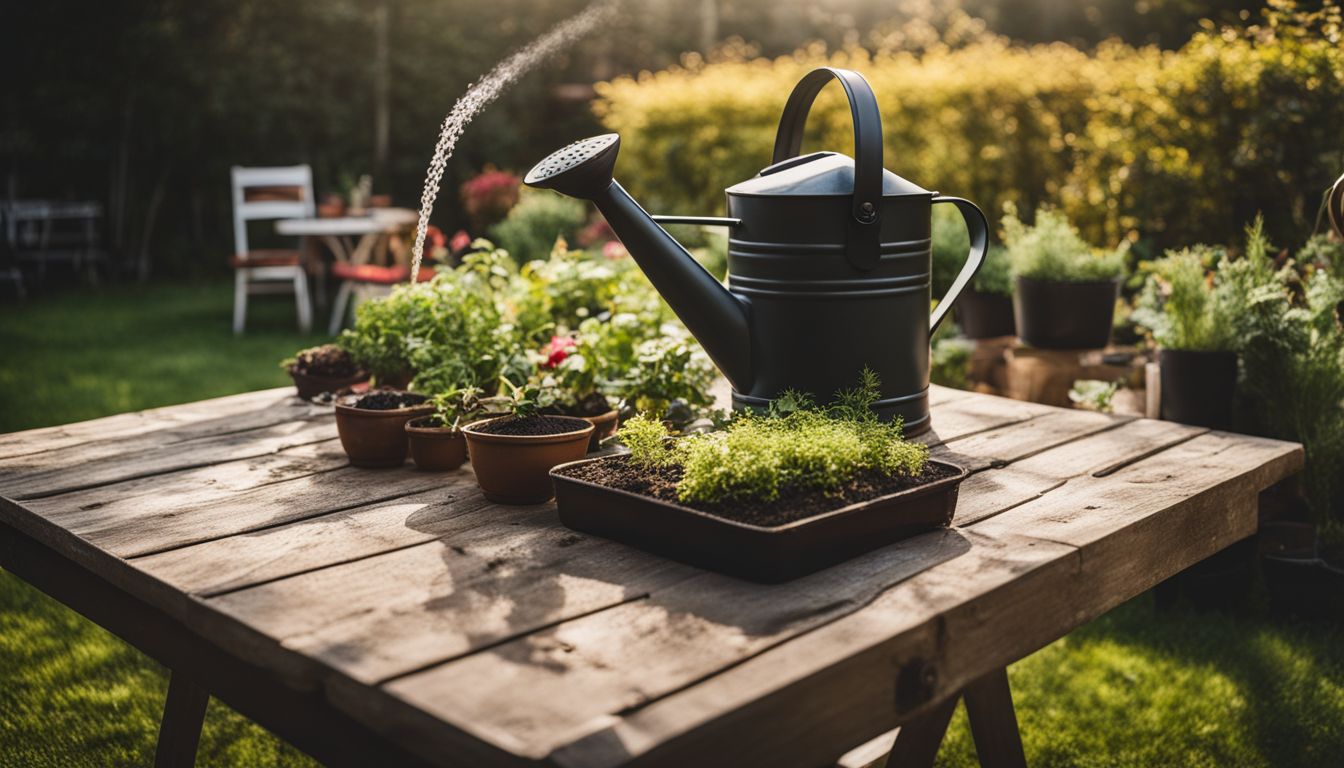Hello, plant friends! Today we’re talking about Philodendron Birkin light care. This is a special houseplant with leaves that have beautiful stripes. Taking care of it means giving it the right light, water, and food to help it grow big and strong.
Philodendron Birkin loves to sit in a place where there’s lots of light but no direct sun hitting its leaves. The best spot for it gets bright light without being too harsh. Getting this right keeps its striped leaves looking their best without getting burn marks.
The perfect soil mix for this plant has stuff like perlite and bark mixed in. This helps hold some water but also lets extra water flow away so the roots don’t get too wet. We want to give our Philodendron Birkin enough water without drowning it.
Usually, watering once a week is good.
We can also use moss poles or sticks to support our Birkins as they get taller and help them stay straight-up instead of floppy.
For temperature, think warm like where they come from – between 65-85°F is great for them. They also love moist air around them just like their tropical home!
When spring comes and plants start growing faster, we feed our Birkin with fertilizer every two weeks – they really love some extra nitrogen for those pretty leaves.
If you have your Philodendron Birkin for a while, you might see little roots coming out on top of the soil; that tells us it’s time to move it into a bigger pot so its roots can spread out more.
And if you find yourself wanting more than one plant, I’ll show you how to make new baby plants from cuttings – isn’t that cool?
Now let’s keep going! Discover all the tips I’ve gathered on keeping your Philodendrons happy!
Key Takeaways
- Philodendron Birkin needs bright, indirect light to grow well. Use sheer curtains or place the plant further from a window to avoid direct sun.
- Water your Birkin when the top inch of soil is dry and use a potting mix that drains well to prevent root rot.
- Support with moss poles if you don’t want your Birkin to get leggy. This helps it stay upright and healthy.
- Keep your plant in a warm spot between 65°F and 85°F (18°C – 29°C), and make sure it has high humidity for best growth.
- Fertilize every other week during the growing season for lush leaves, but be careful not to overdo it.
Optimal Lighting for Philodendron Birkin

For optimal growth, Philodendron Birkin requires bright, indirect light. Understanding the nuances of this lighting requirement and adjusting to your home’s specific conditions is crucial for the plant’s health and vibrancy.
Understanding Bright, Indirect Light
Bright, indirect light is like a cozy spot for your Philodendron Birkin. It’s the kind of light that shines on the plant but not directly. Imagine a sunny room where sunlight bounces off walls and fills the space without hitting the leaves too hard.
This type of lighting keeps your plant happy without burning its lovely leaves.
To get this just right, I place my Birkin near a window with sheer curtains. The thin curtain helps to soften harsh direct sunlight into that gentle glow plants love. Think about how you wear sunglasses on a bright day — it’s pretty much like giving your plant shades! Keep an eye out for signs of too much sun, like brown spots or faded colors, and move your plant if needed.
My trick is to rotate the pot every week so all sides get equal light – this ensures even growth and keeps those variegated patterns looking sharp. Just don’t put it in dark corners or super sunny spots; both can make the plant unhappy.
Trust me, with some attention to their light needs, these beauties truly flourish!
Adjusting to Your Home’s Light Conditions
Now that we know Philodendron Birkin thrives in bright, indirect light, let’s talk about making your home just right for it. Every house is different, with some rooms sunnier than others.
It’s my job to find a spot where my plant gets enough light without the harsh rays of direct sunlight hitting it. This can be tricky since too much shade isn’t good either.
I like to place my Philodendron Birkin near an east or north-facing window where the sun is gentle. If there are only south or west-facing windows around, I use sheer curtains to soften the light.
Another trick is moving it further away from the window or placing it in a room with lots of ambient brightness but no direct beams coming in.
To make sure my plant gets consistent light during the day, I sometimes turn it so all leaves get their share of sunshine. Keeping an eye on how its leaves react helps me adjust its position perfectly over time – they tell me if they need more light or less by how they grow and look!
Soil and Water Requirements

The best soil mix for Philodendron Birkin includes a well-draining potting mix to prevent root rot. As for watering, establishing a consistent schedule and allowing the top inch of soil to dry out between waterings is key to maintaining optimal hydration without overwatering.
Best Soil Mix for Healthy Growth
I use a high-quality potting mix with added perlite and bark to help my Philodendron Birkin stay healthy. This special blend makes sure the roots don’t sit in water, which can lead to root rot.
Peat is also part of the mix because it holds moisture, giving my plant the right amount of water it needs without being too wet.
For a thriving Philodendron Birkin, I always choose soil that keeps moisture but drains well. My perfect potting soil helps get air to the roots and gives them all the nutrients they need for growing strong.
Remembering this balance helps prevent overwatering problems and sets my green friend up for success.
Watering Schedule for Hydration Without Overwatering
I water my Philodendron Birkin once a week, checking the top inch of soil for dryness. Here are the details on how to water your plant without overwatering:
- Water the plant once a week, adjusting based on environmental conditions and seasonality.
- Check the top inch of soil for dryness before watering to ensure the plant’s hydration needs are met without overwatering.
- Use well-draining, nutrient-rich soil to prevent waterlogging and allow excess water to drain out thoroughly.
- When watering, soak the entire pot until the soil is fully moistened, then let excess water drain out completely.
- Avoid excessive moisture in the soil as Philodendron Birkin plants tolerate drought better than overwatering.
Supporting Philodendron Birkin with Moss Poles
Philodendron Birkin plants can benefit from support like moss poles to keep them from getting leggy. While not essential, using a moss pole helps the plant grow healthily and stay compact.
It’s crucial for Philodendron Birkin to have this kind of support, as it assists the plant in thriving and maintaining its attractive appearance. With a moss pole, these plants can develop strong roots and avoid becoming messy or overgrown.
Supporting Philodendron Birkin with moss poles indoors ensures their health and growth. The use of a well-constructed moss pole promotes the beauty and longevity of your cherished houseplant while aiding its upward journey toward lush maturity.
Temperature, Humidity, and Fertilization
Temperature, humidity, and fertilization are crucial factors in the care of Philodendron Birkin. It’s important to maintain an ideal temperature range, provide adequate humidity levels, and fertilize the plant for healthy growth and lush foliage.
Understanding these elements will ensure your Philodendron Birkin thrives in its environment.
Ideal Temperature Range
The ideal temperature for Philodendron Birkin is 65-85°F (18-29°C). This range supports healthy growth. If it gets colder than 55°F, the plant’s growth can slow down. Philodendron Birkin prefers warm and humid conditions similar to its native environment where temperatures range from 75-85°F (24-29°C).
Maintaining this optimal temperature range promotes lush leaves and overall health.
To ensure your Philodendron Birkin thrives, keep the temperature between 65ºF (18ºC) and 85ºF (29ºC). Warmer temperatures are preferred for healthy growth and development.
Humidity Preferences
Philodendron Birkin loves high humidity. It thrives in a warm, humid environment. The plant’s tropical nature benefits from high humidity levels.
To provide the ideal conditions, consider placing it in a bathroom or near other sources of humidity. This ensures its growth and lush leaves are well-supported by the moisture in the air.
High humidity is beneficial for maintaining the health and vibrancy of this houseplant.
Fertilization for Lush Leaves
Fertilizing the Philodendron Birkin is crucial for promoting healthy foliage growth and ensuring lush leaves. By providing the plant with the necessary nutrients, such as nitrogen, we encourage vibrant greenery.
During the growing season, it’s essential to fertilize every other week to support the plant’s development and aid in manufacturing those coveted lush leaves.
The application of fertilizer directly contributes to overall plant health and appearance. It aids in maintaining an optimal level of nourishment needed for robust leaf production.
Troubleshooting Common Issues
If you notice yellowing leaves or brown tips on your Philodendron Birkin, there are specific steps to remedy these common issues and ensure the health of your plant. Learn how to address these problems and keep your Birkin thriving!
Dealing with Yellowing Leaves
Dealing with yellowing leaves is essential for the health of your Philodendron Birkin plant. Here’s how to address this common issue:
- Monitor watering habits and ensure the soil is consistently moist but not waterlogged.
- Use distilled or filtered water to avoid salts from tap water, which can lead to yellowing leaves.
- Maintain adequate humidity levels by misting the plant regularly or using a humidifier.
- Check for aphids and spider mites, which can cause yellowing leaves and address infestations promptly.
- Identify the temperature preferences of the Philodendron Birkin and ensure it is within the ideal range.
Remedying Brown Tips and Curling
When the tips of Philodendron Birkin leaves start turning brown or curling, it’s essential to take prompt action to restore the plant’s health. Here are the steps to remedy these issues:
- Ensure proper watering: Check the soil moisture regularly and water the plant when the top inch of soil feels dry. Avoid overwatering, which can lead to root rot and brown tips.
- Increase humidity: Place a humidity tray or pebble tray filled with water near the plant to boost moisture in the air around it. Misting the leaves can also help increase humidity levels.
- Adjust lighting: If the plant is exposed to direct sunlight, move it to a spot with bright, indirect light to prevent leaf scorching and browning.
- Trim affected leaves: Use clean pruning shears to trim any leaves with severe browning or curling to promote new growth and maintain the overall appearance of the plant.
- Maintain consistent temperature: Keep the Philodendron Birkin in a location with stable temperatures, avoiding sudden fluctuations that can stress the plant and contribute to leaf problems.
- Fertilize cautiously: If using fertilizer, follow recommended dilution rates and avoid excessive feeding, as overfertilization may exacerbate leaf issues.
- Monitor for pests: Regularly inspect the plant for signs of pests such as spider mites or aphids, as their presence can lead to leaf damage and browning.
- Provide adequate airflow: Ensure good air circulation around the plant by placing it in a well-ventilated area, which can help prevent fungal issues that may contribute to leaf problems.
Propagation and Repotting
Successfully propagating Philodendron Birkin can be done through stem cuttings in water or soil, and knowing when to repot your plant is essential for its continued growth and health.
For a detailed guide on propagation and repotting, continue reading to ensure your Birkin plant thrives.
Steps for Successful Propagation
To propagate Philodendron Birkin, follow these steps:
- Select a healthy stem cutting with at least one node and some aerial roots. This ensures the cutting has the potential to grow into a new plant.
- Trim the cutting just below a node using clean, sharp scissors or pruning shears to promote successful root development.
- Place the cutting in a clear container filled with water, ensuring that at least one node is submerged. Change the water every few days to prevent rot and encourage healthy root growth.
- Position the container in a warm, bright location away from direct sunlight, as excessive heat or light can damage the cutting.
- Monitor the progress closely, as it typically takes 6 – 8 weeks for new roots to emerge from the nodes of the cutting.
- Once substantial root growth is observed, carefully transplant the cutting into a suitable potting mix, ensuring good drainage to support its ongoing growth.
- Keep the newly potted cutting in optimal lighting conditions and maintain consistent humidity levels to facilitate its transition into a thriving Philodendron Birkin plant.
Knowing When to Repot
I repot my Philodendron Birkin every 12-24 months to give it more room to grow. When the roots start poking out of the drainage holes in the bottom of my pot, it’s time to consider repotting. Here are key signs indicating when to repot:
- Overcrowded Roots: If I notice roots circling the pot or pushing up through the soil, it’s a clear indication that my plant needs a larger home.
- Slowed Growth: When I observe stunted growth despite proper care, it suggests the plant has exhausted its current space and nutrients.
- Visible Soil Depletion: As nutrients deplete over time, I see reduced soil volume in the pot, signaling that it’s time for fresh soil and a larger container.
- Watering Difficulties: If watering leads to excess runoff because the water can’t penetrate the root ball easily anymore, then it’s likely time for a bigger pot.
Conclusion: Thriving Birkin Plant Care
In conclusion, mastering Philodendron Birkin light care is key to its thriving growth. The practical strategies provided in this guide are easy to implement and efficient for plant enthusiasts.
Emphasizing the right levels of warmth, moisture, and bright, indirect light can lead to significant improvements in plant health. For further learning and engagement, additional resources or services can be explored by the reader.
Remember, with proper care and attention, your Philodendron Birkin will reward you with lush foliage and vibrant beauty.
FAQs
1. What kind of light does a Philodendron Birkin need?
A Philodendron Birkin needs bright, indirect sunlight to grow well.
2. Can I put my Philodendron Birkin in direct sun?
No, you should not put your Philodendron Birkin in direct sun because it can hurt the plant.
3. Is a Philodendron Birkin good to have inside as a house plant?
Yes, a Philodendron Birkin is great as a house plant because it likes the light found in homes.
4. Should I use mulch for my indoor Philodendron Birkin?
Mulch isn’t needed for indoor plants like the Philodendron Birkin since they are grown in pots with proper soil that holds moisture and nutrients.




